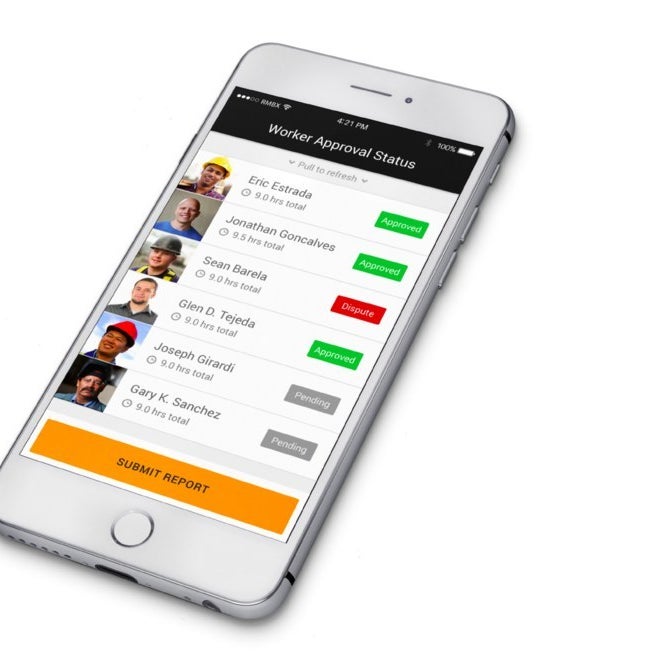
When Yves Frinault first started talking about building Fieldwire, a task-management app for foremen working commercial construction projects, he was told it was a longshot. "People were like, ‘foremen will never have smartphones,’" Frinault told BuzzFeed News. But one day while hanging around on-site — Frinault has a degree from Stanford in construction management — he saw a burly-looking worker pull off his gloves, stick his hand in his pocket, and pull out a smartphone. He decided lack of access to personal devices wasn't going to be a problem.
In fact, construction sites are already much more tech-rich than you might imagine. Sensor-enabled wearables communicate gestures, geofencing systems outline work sites, and accelerometers track movement. Much of that is in the service of safety — construction is a high-risk job — but all this tracking also means that construction workers stand to lose the privacy that people in other industries take for granted.
According to Frinault, 30% of time workers spend on-site at commercial construction projects is idle — not because workers are lazy, but largely because of miscommunication and disorganization. There's also the problem of "rework" — doing a task, and then having to do it over again. For example, a subcontractor might be told to cover a hole with drywall; the next day, an electrician who wasn't finished wiring an outlet comes in and tears that drywall out again, and the drywall hanger has to come back and redo it. With Fieldwire, Frinault hopes to improve the communication channels between subcontractors.
His app, which raised $6.6 million in October, doesn't locate workers on a map; it locates tasks on a blueprint — tasks that foremen can then check off in real time as they are completed. The purpose of Fieldwire is to record and share information as synchronously as possible. "It may seem invasive," said Frinault's co-founder Javed Singha, "but the reality is these guys are recording all this information manually anyway."
Even so, subcontractors aren't always thrilled about sharing all that information. Traditionally, they operate independently; being asked to share how long projects are taking or how many workers are required to complete them can be uncomfortable. "I don't think the entire market is ready," Frinault said. Some of it is, though: Fieldwire is being used on-site at over 35,000 construction projects in Japan, Australia, the U.K., France, and the the U.S. — including on the remodeling of the home of one of Fieldwire's funders, Thomas Korte of AngelPad.
Rhumbix, an app meant to be in the hands of the workers themselves, is making an even bolder ask in terms of transparency. Not only do workers clock every hour of their day on Rhumbix, but the app also tracks their location, and even some of their movements. Rhumbix is the invention of two former Navy engineers, Drew DeWalt and Zach Scheel, who took a class together at Stanford and decided to build a startup. "I said, every phone has GPS in it," Scheel told BuzzFeed News. "Let's try to create a system like the ones we use now in the military to help improve the system we use for construction."
With Rhumbix, workers clock in and out at the beginning and end of each work day. While they’re on the clock, the app tracks their movements, both in terms of motion (moving or stationary?) and location (on the job or out to lunch?). This data is presented to managers in two ways: as a live safety snapshot, which shows where workers are at any given time, and as aggregated and anonymized labor time data that can help the bosses figure out how much is being spent on different activities. This tracking can benefit the worker — for example, a worker who had passed out on a hot roof due to sunstroke was discovered when the Rhumbix app alerted his foreman that he wasn’t moving. But the app can also be used to, say, prove that workers who claim they worked through lunch actually didn’t.
Rhumbix's live safety snapshot keeps track of where individual construction workers are located throughout the day:
View this video on YouTube
Rhumbix says the goal isn't to get individual unproductive workers fired, but to find ways to build more efficient processes for construction sites. Like Frinault, Scheel was adamant that idle time on-site is rarely the result of laziness. "They're almost always waiting on something," said Scheel. “It's the very rare case that they don't want to work." But the bosses — the people who are making the decision to use these apps — don’t always see it that way; some customers have wanted to use Rhumbix to smoke out workers who don’t do their work. "We had to say no to people who wanted to pay us, because that's a shortsighted view of how to get better at construction," said DeWalt.
Systems are in place to ensure that Rhumbix isn't collecting data it shouldn't. Push notifications remind workers to clock out at the end of the day; if they haven't, another notification goes out when their foreman clocks out. On top of that, for the majority of the analytics dashboards that managers look at when trying to increase productivity, the information about individuals is anonymized and aggregated. But Rhumbix does have all the data on where people are and what they're doing, and could theoretically show to it to management — or even third parties — at any time. "You're going to have to trust us a little bit," said DeWalt.


Rhumbix recently announced a partnership with Bechtel, a global construction firm Scheel used to work for managing productivity in Chile's largest copper mine. Bechtel has a $60 million "future fund" that backs Rhumbix; in exchange, Rhumbix gets to test some of its software with workers on Bechtel jobs around the world, while designing a product that will ultimately be sold or licensed to other private companies. Bechtel currently employs 58,000 people globally.
It's not just startups competing to build the best mobile tech tools for construction — major software and engineering companies are also interested. Honeywell, which has long manufactured worker safety equipment like hard hats and boots, today also sells wearable technologies that, for example, measure air quality and alert workers to the danger of gas leaks. Honeywell recently announced a partnership with Intel to expand its "connected worker" initiative, working on products such as sensors that can track the gestures of first responders in critical situations.
Lorie Wigle, who is the general manager of security for Internet of Things projects at Intel, said when safety is the primary concern, privacy often becomes secondary. “We need to weigh the benefit of the solution that we’re implementing against the potential impact to privacy,” she said. “We shouldn’t be collecting data that we don’t really need to collect.”
Mobile technologies with the capacity to track us already permeate our personal lives, but they are going to be increasingly powerful tools for monitoring our working lives as well. It's now, and not later, that privacy protection should be incorporated into these devices. Workers across industries will only see more of this kind of monitoring as the prices of devices fall and the pressure to increase productivity increases. When Silicon Valley entrepreneurs talk about the future of work, they talk about increased freedom; that's not what this kind of monitoring looks like.

